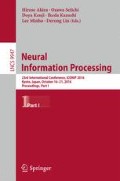Abstract
A service robot requires natural and interactive interaction with users without explicit commands. It is still one of the difficult problems to generate robust reactions for the robot in the real environment with unreliable sensor data to satisfy user’s requests. This paper presents an intention-response model based on mirror neuron and theory of mind, and analyzes the performance for a humanoid to show the usefulness. The model utilizes the modules of behavior selection networks to realize prompt response and goal-oriented characteristics of the mirror neuron, and performs reactions according to an action plan based on theory of mind. To cope with conflicting goals, behaviors of the sub-goal unit are generated using a hierarchical task network. Experiments with various scenarios reveal that appropriate reactions are generated according to external stimuli.
This work was supported by the Industrial strategic technology development program, 10044828, Development of augmenting multisensory technology for enhancing significant effect on service industry funded by the Ministry of Trade, industry & Energy (MI, Korea).
Access this chapter
Tax calculation will be finalised at checkout
Purchases are for personal use only
References
Liu, J., Wong, C.K., Hui, K.K.: An adaptive user interface based on personalized learning. IEEE Intell. Syst. 18(2), 52–57 (2003)
Kuniyoshi, Y., Yorozu, Y., Ohmura, Y., Terada, K., Otani, T., Nagakubo, A., Yamamoto, T.: From humanoid embodiment to theory of mind. In: Iida, F., Pfeifer, R., Steels, L., Kuniyoshi, Y. (eds.) Embodied Artificial Intelligence. LNCS (LNAI), vol. 3139, pp. 202–218. Springer, Heidelberg (2004)
Nicolescu, R.K.M., Nicolescu, A.T.M., Bebis, C.K.G.: Understanding human intentions via hidden markov models in autonomous mobile robots, pp. 367–374. ACM/IEEE Hum. Robot, Interaction (2008)
Duijnhoven, D.V.: The role of the mirror neuron system in action understanding and empathy, Bachelor thesis Cognitive Neuroscience (2010)
Amodio, D.M., Frith, C.D.: Meeting of minds: the medial frontal cortex and social cognition. Nat. Rev. Neurosci. 7(4), 268–277 (2006)
Cross, E.S., Hamilton, A.F.D.C., Grafton, S.T.: Building a motor simulation de novo: observation of dance by dancers. Neuroimage 31(3), 1257–1267 (2006)
Hamilton, A.F.D.C., Grafton, S.T.: Goal representation in human anterior intraparietal sulcus. Neuroscience 26(4), 1133–1137 (2006)
Saxe, R., Powell, L.J.: It’s the thought that counts specific brain regions for one component of theory of mind. Psychol. Sci. 17(8), 692–699 (2006)
Murphy, R.R.: Introduction to AI Robotics. The MIT Press, Cambridge (2000)
Min, H.-J., Cho, S.-B.: Generating optimal behavior of mobile robot using behavior network with planning capability. In: IEEE International Symposium on Computational Intelligence in Robotics and Automation, vol. 1, pp. 186–191 (2003)
Yun, S.-J., Lee, M.-C., Cho, S.-B.: P300 BCI based planning behavior selection network for humanoid robot control. In: Proceedings 9th International Conference on Natural Computation, pp. 354–358 (2013)
Lee-Johnso, C.P., Carnegie, D.A.: Mobile robot navigation modulated by artificial emotions. IEEE Trans. Syst. Man Cybern. Part B Cybern. 40(2), 468–480 (2010)
Quintero, E.A., García-Olaya, Á., Borrajo, D., Fernández, F.: Control of autonomous mobile robots with automated planning. J. Phys. Agents 5(1), 3–13 (2011)
Chae, Y.-J., Cho, S.-B.: An intention-response model based on mirror neuron and theory of mind. In: 10th International Conference on Natural Computation, pp. 380–385 (2014)
Tyrrell, T.: An evaluation of Maes’s bottom-up mechanism for behavior selection. Adapt. Behav. 2(4), 307–348 (1994)
Author information
Authors and Affiliations
Corresponding author
Editor information
Editors and Affiliations
Rights and permissions
Copyright information
© 2016 Springer International Publishing AG
About this paper
Cite this paper
Yu, JM., Cho, SB. (2016). Analysis of an Intention-Response Model Inspired by Brain Nervous System for Cognitive Robot. In: Hirose, A., Ozawa, S., Doya, K., Ikeda, K., Lee, M., Liu, D. (eds) Neural Information Processing. ICONIP 2016. Lecture Notes in Computer Science(), vol 9947. Springer, Cham. https://doi.org/10.1007/978-3-319-46687-3_18
Download citation
DOI: https://doi.org/10.1007/978-3-319-46687-3_18
Published:
Publisher Name: Springer, Cham
Print ISBN: 978-3-319-46686-6
Online ISBN: 978-3-319-46687-3
eBook Packages: Computer ScienceComputer Science (R0)

